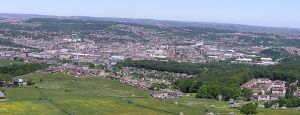Towns: the Final Frontier
Are you a Trekker? If so, which Star Trek series do you prefer? Although I can’t avoid feeling nostalgia for the original Shatner/Kirk series with which I grew up, I do have to admit it now looks pretty creaky, and I prefer its sequel, Star Trek: the Next Generation, chiefly due to the admirable character of Captain Jean-Luc Picard, played with such quiet authority by Patrick Stewart.
Mind you, I was already a Patrick Stewart fan. As a schoolboy I had been taken to Stratford (overnight coach both ways!) to see Richard III, and in a powerhouse RSC cast that included the late Norman Rodway and Ian Richardson, and a luminous Helen Mirren, the youthful but already balding Stewart had held his own as an actor of real presence and integrity, qualities that have sustained his entire career.
He popped up in a different role on our TV last week, as we caught up with recordings Nicholas Crane’s second series of ‘Town’. This episode was on Patrick Stewart’s home town of Huddersfield, where he has been Chancellor of the University since 2004, and by the time he appeared towards the end of the programme, extolling both town and university, we were ready to cheer him on. In fact, Crane had presented such an inspiring picture of the architecture and the people of Huddersfield that we were ready to jump on the next train south and remedy a lifetime’s neglect by finally visiting the town.
One of the peculiarities of Huddersfield is that despite, with a population of 146,000, being considerably larger than many formally designated ‘cities’, it has never sought that city status. The good folk of Huddersfield seem content with their town-ness, and one wonders, what are the virtues of being a ‘town’ that they want to hang on to? (Inverness, are you listening?) For the past few months I’ve been a member of an External Advisory Group to the Scottish Government’s Town Centre Review, the report of which was published earlier this month. Inevitably, I don’t agree with everything that’s in the Review, but the process of working on it has been eye-opening.
Half of Scotland’s population live in its 500-odd towns, and yet those towns rarely seem to benefit from any specific and focused Government strategies or policies. There have been Six (and now Seven) Cities Initiatives, and I’ve spent most of the last 20 years focusing on rural initiatives, but towns often seem like poor relations, as if there was something inherently dull or old-fashioned about the very idea of a ‘town’–exactly the prejudice which Crane’s series is trying to overturn. It doesn’t help that the concept of ‘town’ is a wide and slippery one. Like Huddersfield some Scottish towns–Paisley, East Kilbride–are considerably larger than the three new cities of Inverness, Stirling and Perth, but there are also anomalies at the other end of the scale. I realised, writing this, that I have never actually lived in a town, although we’d spent twelve years in Anstruther, which is usually referred to as a village despite, with 3,600 people, being larger than many so-called towns.
Of course there are many handsome and prosperous towns in Scotland–St Andrews, Banchory and North Berwick are among those I know well–but the ‘problem’ towns are not confined to the obvious post-industrial areas such as Ayrshire or West Lothian. Rural Perthshire towns such as Crieff and Aberfeldy, for example, have suffered from the steady retreat of their commercial sectors, while many Border towns are affected by their ready access to the metropolises of Glasgow and Edinburgh.
That the arts can play an important role in reviving a flagging town has been amply demonstrated by Wigtown (book town), Kirkcudbright (art town) and West Kilbride (craft town), but also, without the need for such formal designations, by the development of cultural facilities, such as An Lanntair in Stornoway or the new Beacon in Greenock. But what some of us were trying to argue in the Town Centre Review is that a cultural approach to improving our towns needs to go much deeper. More technical interventions, such as changes to the process of business rates, or getting more town centre properties scheduled as residential, are only really going to be effective, we argued, if applied in the context of a thorough understanding of the different culture of each town—its history, how it grew up, the stories its inhabitants tell about it, what its young people think of it.
That after all is exactly Nicholas Crane’s thesis: that towns can be the machines for living in the future, that they can be capable of change and adaptation, but that you need to understand where each individual town is starting from to kickstart such change. For me, that message doesn’t come across quite strongly enough in the Review’s final report, but at least it’s a start. Now we just need someone with sufficient authority to take the Review’s recommendations and declare, in the immortal words of Jean-Luc Picard, ‘Make it so!’.
© Robert Livingston



Recent Comments